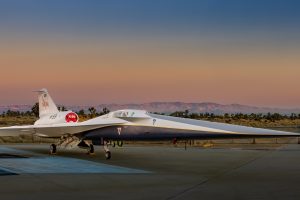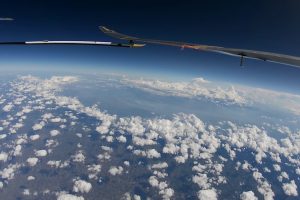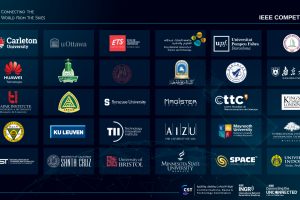It was the final demo prior to a self-funded space mission. The plan is that, next year, the company will launch this payload to orbit to bring space-based 5G capabilities to terrestrial users.
Lockheed Martin’s base station includes a full 5G New Radio (NR) Radio Access Network (RAN) stack, RAN Intelligent Controller (RIC) and a 5G Stand Alone (SA) Core. These were running on the space-qualified flight hardware that will fly on a satellite.
The system is reprogrammable in orbit using the company’s SmartSat software-defined satellite architecture, said the company. It connected to prototype NTN user equipment through a space communications channel emulator that introduced doppler and delay parameters consistent with a satellite Low Earth Orbit.
Lockheed Martin also highlighted that it can be structured with a split architecture placing the Control Unit (CU) on the ground and the Distributed Unit (DU) on the satellite, for different network implementation options.
Base Station demo
The demonstration, in a live hardware-in-the-loop lab environment – which actually took lace last month – saw an Advanced 5G NTN Satellite Base Station connect with prototype NTN user equipment, for high-speed data transfers. This was compliant with 3GPP Release 17, an industry standard for improved radio flexibility and low latency, highlights the company.
During a simulated satellite orbital pass, the Satellite Base Station, running on space-hardened flight hardware, and the user equipment on the ground successfully connected and transferred data, which included live video streaming.
“Space layer capabilities are essential for consistent, secure connectivity and global coverage for 5G communications systems. 5G from space will enable Joint All-Domain Command and Control operations especially in austere environments, remote locations and contested areas,” said Joe Rickers, Lockheed Martin’s vice president for Connectivity, Transport and Access.
“Our Satellite Base Station is real, operational hardware and we’re excited for the next step – integrating this powerful payload into our self-funded Tactical Satellite which we’ll launch next year.”
Partners
Three subcontractors were also involved in testing the Lockheed space system: AccelerComm, Radisys and Keysight Technologies.
AccelerComm provided an advanced 5G NTN Layer 1 PHY solution to space flight hardware specifications. Radisys supplied 5G NTN Layer 2/3 and 5G SA Core software, enabling integration with L1 and RIC systems. And Keysight supported 3GPP standards-based development testing of Lockheed Martin’s 5G NTN base station via its 5G NTN user equipment simulation (UeSIM) product suite.
AccelerComm
As mentioned, AccelerComm provided an advanced 5G NTN Layer 1 PHY solution.
“5G satellite communication promises to unlock a whole new world of services and applications for government organisations and individuals, and we are proud to have worked with Lockheed Martin and its partners on delivering this vision,” said AccelerComm’s CEO Tom Cronk.
“A space-deployed, scalable 3GPP Release 17 compatible 5G gNodeB proves that 5G NTN communications is a reality. AccelerComm’s LEOphy delivers higher data rates with reduced power and has dedicated features to overcome the specific challenges of NTN channels. We look forward to continuing our partnership, and to further developing advanced 5G Layer 1 NTN solutions that deliver the robustness, latency, and throughput that are critical to the success of 5G in space.”
You can read more about the project here.
Radisys
On the software side of things, Radisys highlighted changing communication needs:
“Radisys is pleased to achieve this successful 3GPP-based satellite connectivity demonstration in partnership with Lockheed Martin to advance NGSO SATCOM solutions for rapidly evolving global communication needs,” said Munish Chhabra, Senior Vice President & General Manager, Software and Services, Radisys.
Keysight
Keysight Technologies provided its 5G NTN user equipment (UE) simulator and Wavejudge wireless analyser to help the testing of Lockheed’s 3GPP-compliant NTN base station.
“Our UE simulator provided validation of the base station’s required behaviors and performance, including during integration testing on reference flight hardware and early hardware-in-the loop (HWIL) confidence demonstrations,” said Vince Nguyen, General Manager of Aerospace, Defense, and Government Solutions at Keysight Technologies. “Keysight looks forward to continuing to provide software and hardware emulation tools to accelerate the technology advancement of 5G NTN Base Stations together with Lockheed Martin and its partners.”
Space 5G
We recently reported in September that UNIO, a German space startup, achieved pre-seed investment totalling €2.5 million to speed the development and market launch of its UNIO ‘bridge’ product. This is enterprise-class commercial vehicle system is designed to provide ‘always-on’ connectivity, specifically for connected vehicles transitioning between 5G and satellite connectivity. It’s aimed at both the logistics and agricultural sectors, with first products expected to be delivered in “early 2024”, with a full customer rollout slated for Q3 2024.
Last month, Mira Aerospace announced its “ApusDuo” solar aircraft had also successfully conducted a 5G connectivity test, delivering comms from a fixed-wing HAPS (high altitude pseudo satellite) autonomous aircraft in the stratosphere.
The demonstration was conducted in Rwandan airspace and delivered 5G connectivity for approximately 73 minutes in the stratosphere, says the company, during which it reached a maximum altitude of 16.9 km. As part of the test, the 5G communications payload enabled a 5G Zoom video call.
Finally, at the start of this month, AST SpaceMobile announced it had achieved a space-enabled 5G cellular broadband connection, on a standard smartphone, in its latest test ahead of launching a commercial service in 2024.
The connection used the company’s BlueWalker 3 test satellite and AT&T spectrum – in collaboration with Vodafone, AT&T, and Nokia – and AST SpaceMobile says it shows the promise for filling coverage gaps around the world with 4G and 5G broadband connectivity from space. The 5G call was placed, from an unmodified Samsung Galaxy S22, by company engineers in Maui, Hawaii – a tropical landscape in a “cellular deadzone” – to a Vodafone engineer in Madrid.
Image: Lockheed Martin
See also: Northumbria Uni, Lockheed Martin detect nanojets with ML algorithms
 Electronics Weekly Electronics Design & Components Tech News
Electronics Weekly Electronics Design & Components Tech News




